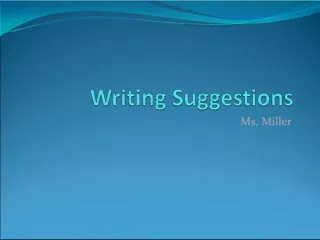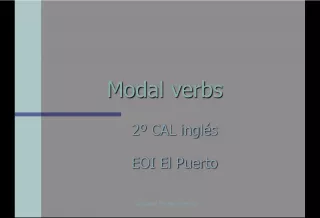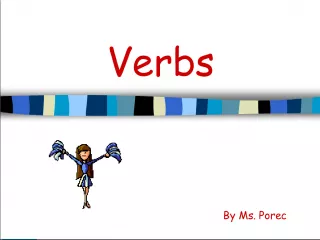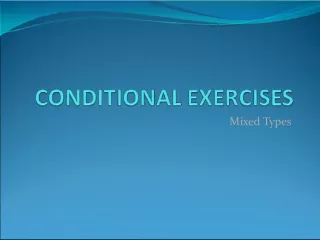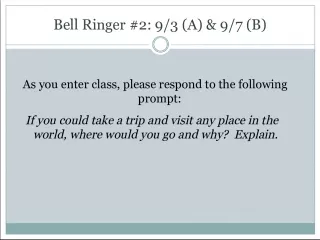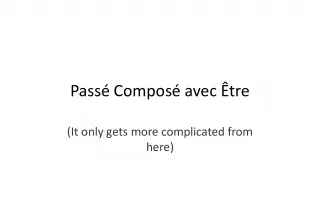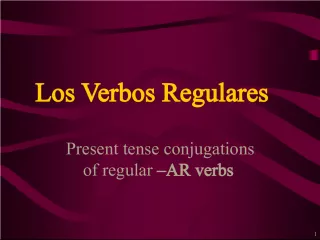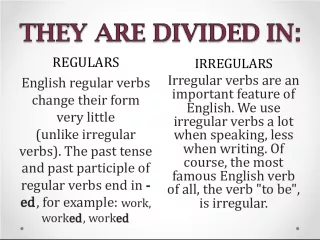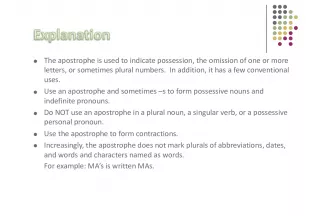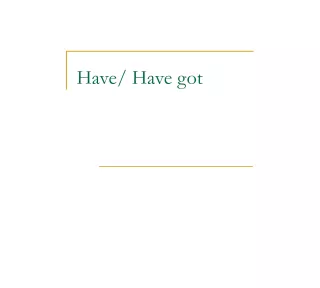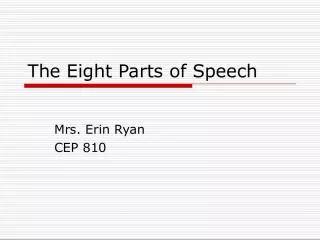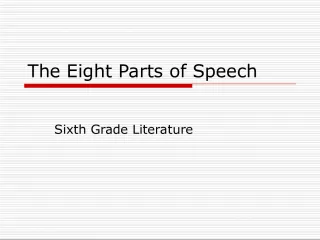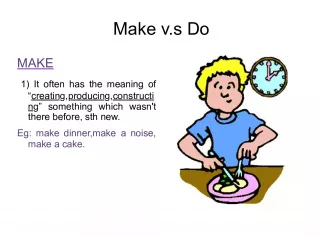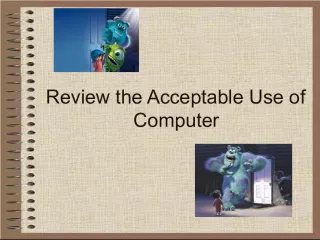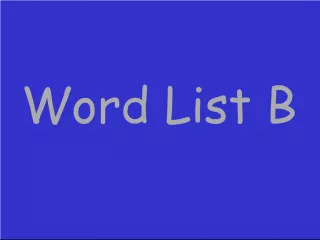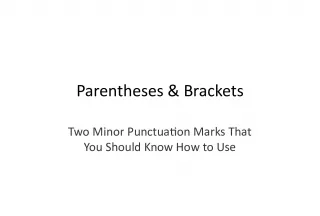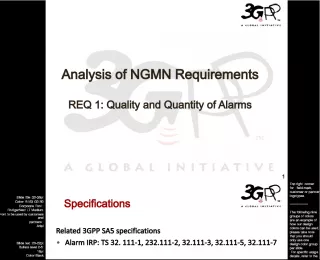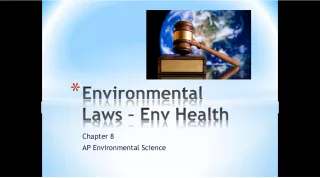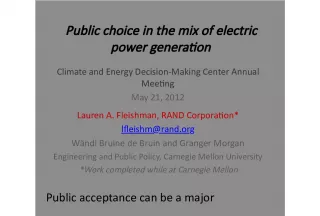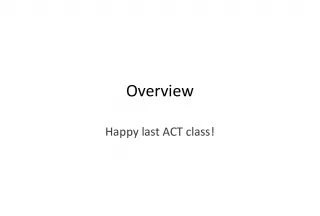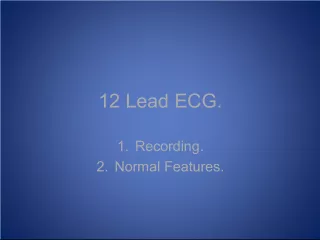Correct Usage of the Preposition "Of" with Verbs
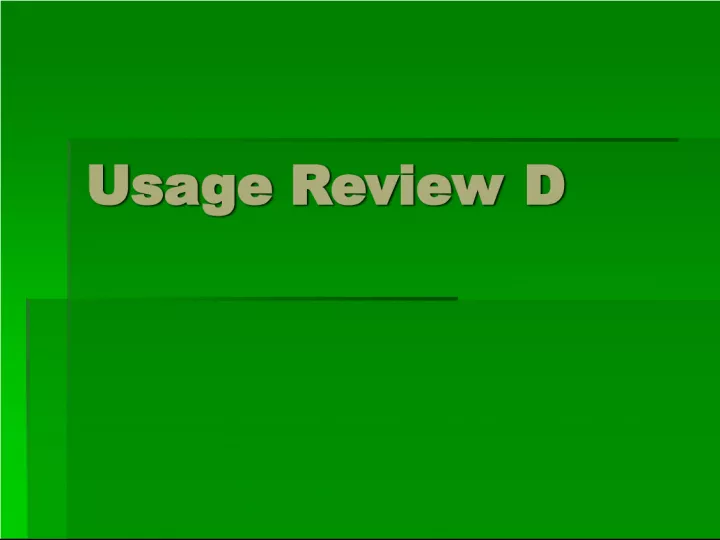

This usage review focuses on the proper use of "of" as a preposition with verbs, particularly in cases where it is often mistakenly used in place of "have
- Uploaded on | 1 Views
-
 randall
randall
About Correct Usage of the Preposition "Of" with Verbs
PowerPoint presentation about 'Correct Usage of the Preposition "Of" with Verbs'. This presentation describes the topic on This usage review focuses on the proper use of "of" as a preposition with verbs, particularly in cases where it is often mistakenly used in place of "have. The key topics included in this slideshow are . Download this presentation absolutely free.
Presentation Transcript
Slide1Usage Review D Usage Review D
Slide2ofof Of is a preposition. Do not use in place of have after verbs such as could , should , would , might , must, and ought to . Of is a preposition. Do not use in place of have after verbs such as could , should , would , might , must, and ought to . Incorrect: You should of studied more for the test. Incorrect: You should of studied more for the test. Correct: You should have studied more for the test. Correct: You should have studied more for the test.
Slide3Raise, rise Raise, rise Raise means "to make higher," "build," or "nurture and cause to grow." It is normally transitive, that is, the action is done to something or someone else. Raise means "to make higher," "build," or "nurture and cause to grow." It is normally transitive, that is, the action is done to something or someone else. Correct: They raised the barn in two days. Correct: They raised the barn in two days. Rise means "to get up" or "become elevated." It is never transitive. The past tense is rose; the past participle, risen. Rise means "to get up" or "become elevated." It is never transitive. The past tense is rose; the past participle, risen. Correct: The sun rises and sets every day. Correct: The sun rises and sets every day.
Slide4sit, set sit, set Set means to "put in a certain place." It is normally followed by a direct object, that is, it acts upon something else. It is transitive. Set means to "put in a certain place." It is normally followed by a direct object, that is, it acts upon something else. It is transitive. Sit means "to be seated." It is always intransitive. Sit means "to be seated." It is always intransitive. Incorrect: Set down on this chair. Incorrect: Set down on this chair. Correct: Sit down on this chair. Correct: Sit down on this chair. Incorrect: Sit the money on the counter. Incorrect: Sit the money on the counter. Correct: Set the money on the counter. Correct: Set the money on the counter.
Slide5than, then than, then “Than” is the word you want when doing comparisons. But if you are talking about time, choose “then.” “Than” is the word you want when doing comparisons. But if you are talking about time, choose “then.” Incorrect: Alexis is more skilled at the piano then I. Incorrect: Alexis is more skilled at the piano then I. Correct: Alexis is more skilled at the piano than I. Correct: Alexis is more skilled at the piano than I.
Slide6their, there, they’re their, there, they’re Their is a possessive pronoun. It always describes a noun. Their is a possessive pronoun. It always describes a noun. Note the spelling of their. It comes from the word they, so the e comes before the i. Note the spelling of their. It comes from the word they, so the e comes before the i. There is an adverb meaning "that location." It is sometimes used with the verb to be as an idiom. It is spelled like here which means "this location." There is an adverb meaning "that location." It is sometimes used with the verb to be as an idiom. It is spelled like here which means "this location." They're is a contraction of they are. Note the spelling: The a from are is replaced by an apostrophe. They're is a contraction of they are. Note the spelling: The a from are is replaced by an apostrophe.
Slide7their, there, they’re their, there, they’re Examples: Examples: Their dog has fleas. (possessive of they ) Their dog has fleas. (possessive of they ) I put the collar right there. (that location) I put the collar right there. (that location) There are five prime numbers less than ten. (with to be ) There are five prime numbers less than ten. (with to be ) They're 1, 2, 3, 5, and 7. (contraction of they are ) They're 1, 2, 3, 5, and 7. (contraction of they are )
Slide8theirs, there’s theirs, there’s Theirs is a possessive pronoun. Theirs is a possessive pronoun. There's is a contraction for there is or, rarely, there has. Note the apostrophe replacing the missing letter or letters. There's is a contraction for there is or, rarely, there has. Note the apostrophe replacing the missing letter or letters. Their's does not exist. Their's does not exist.
Slide9their, there, they’re their, there, they’re Examples: Examples: That painting is theirs. That painting is theirs. (possessive pronoun) (possessive pronoun) There's more to this than meets the eye. There's more to this than meets the eye. (contraction of there is) (contraction of there is)
Slide10who, which that who, which that Who (and its inflections, whom and whose ) is used to refer only to people or to entities treated as people (e.g., gods, or anthropomorphized pets). Who (and its inflections, whom and whose ) is used to refer only to people or to entities treated as people (e.g., gods, or anthropomorphized pets). That is used to refer to animals, things, or people. Although as a general rule who is preferred for people, that is also acceptable for referring to people when the relative clause is restrictive, and sometimes using that will make the sentence read better. That is used to refer to animals, things, or people. Although as a general rule who is preferred for people, that is also acceptable for referring to people when the relative clause is restrictive, and sometimes using that will make the sentence read better.
Slide11This is the boy who stole money from an old man who had gone out of his way to help him. This is the boy who stole money from an old man who had gone out of his way to help him. This is the boy that stole money from an old man that had gone out of his way to help him. This is the boy that stole money from an old man that had gone out of his way to help him. This is the boy that stole money from an old man who had gone out of his way to help him. This is the boy that stole money from an old man who had gone out of his way to help him. This is the boy who stole money from an old man that had gone out of his way to help him. This is the boy who stole money from an old man that had gone out of his way to help him. Although all of four these sentences are "correct," the last two examples read better than the first two, because they avoid awkward repetitions. Although all of four these sentences are "correct," the last two examples read better than the first two, because they avoid awkward repetitions. who, which that who, which that
Slide12who, which that who, which that Which is used to refer to things or animals, not people. When the clause is nonrestrictive , use who , not which to refer to people. Which is used to refer to things or animals, not people. When the clause is nonrestrictive , use who , not which to refer to people. Examples: Examples: The books, which are on the table, are antiques. The books, which are on the table, are antiques. The students, who are waiting patiently, are ready to leave for the summer. The students, who are waiting patiently, are ready to leave for the summer.
Slide13who’s, whose who’s, whose “Who’s” always and forever means only “who is,” as in “Who’s that guy with the droopy mustache?” or “who has,” as in “Who’s been eating my porridge?” “Whose” is the possessive form of “who” and is used as follows: “Whose dirty socks are these on the breakfast table?” “Who’s” always and forever means only “who is,” as in “Who’s that guy with the droopy mustache?” or “who has,” as in “Who’s been eating my porridge?” “Whose” is the possessive form of “who” and is used as follows: “Whose dirty socks are these on the breakfast table?”
Slide14your, you’re your, you’re You're is the contracted form of You are . This form is used in sentences using "you" as the subject of the sentence with the verb "to be" used as either the helping verb (e.g. You're going ..., You're watching ...) or the principal verb of the sentence. Your is the possessive pronoun form. This form is used to express that something belongs to "you". You're is the contracted form of You are . This form is used in sentences using "you" as the subject of the sentence with the verb "to be" used as either the helping verb (e.g. You're going ..., You're watching ...) or the principal verb of the sentence. Your is the possessive pronoun form. This form is used to express that something belongs to "you".
